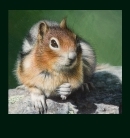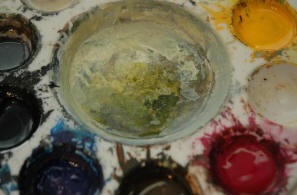
Art Classes
Instructional DVDs
Art Tips
Step by Step
|
| Home | Main | Links | Site Map | Classroom |
Art Tips
Limiting your Palette
I wanted to point out some of the advantages of limiting the number of colours in your palette.
 For a new artist, nothing can compare to the exploration of mixing a
particular colour, as opposed to shopping for it. The relationship
between colours is easier to understand when you mix your own. For
instance, everyone knows that blue and yellow can be mixed to make
green. However, there is a wide range of greens, from very cool to
very warm, depending on the amount of each colour you use. On top
of that, adding complementary colours, Payne's Grey, or white, for
example, will further broaden the range of greens you are able to
create.
For a new artist, nothing can compare to the exploration of mixing a
particular colour, as opposed to shopping for it. The relationship
between colours is easier to understand when you mix your own. For
instance, everyone knows that blue and yellow can be mixed to make
green. However, there is a wide range of greens, from very cool to
very warm, depending on the amount of each colour you use. On top
of that, adding complementary colours, Payne's Grey, or white, for
example, will further broaden the range of greens you are able to
create.
The next advantage to limiting your palette, applies to both the new and the more experienced artist: cost. Those who sell art supplies will try to convince you that you need to buy every colour they carry. In reality, all you really need are five basic colours, from which all others can be mixed. Why have a collection of unused or half-used, dried out paints? In the long run, the savings can really add up. Besides, when you buy only a few colours, you can afford to buy the best quality available. New artists also have the flexibility of experimenting with different media, before committing to a specific one, without having to make a huge investment in materials.
Another benefit is portability. With a few basic colours and the confidence that all other colours can be mixed from them, the arsenal you have to carry is minimal. With acrylics, for instance, you could work virtually anywhere, from an airplane seat to a river bank.
Brand selection is up to you, but when you buy a colour designated as "primary" from one manufacturer, buy the other two primary colours from the same manufacturer. With my style of acrylic paintings, I prefer to work with medium viscosity (jar) paints, as opposed to high viscosity (tube) paints. The five colours from which I mix the majority of my colours are:
|
|
Titanium White |
|
|
Magenta Deep |
|
|
Cadmium Yellow Deep |
|
|
Phthalocyanine Blue |
|
|
Payne's Gray |
Occasionally, I also work with Burnt Umber (jar) because it is a common colour in most of the subjects I paint. You may find that there is a colour that you use so often, (purple for flowers, siennas for skin tones, etc.) that it is a better use of your time to purchase it as a pre-mixed colour.